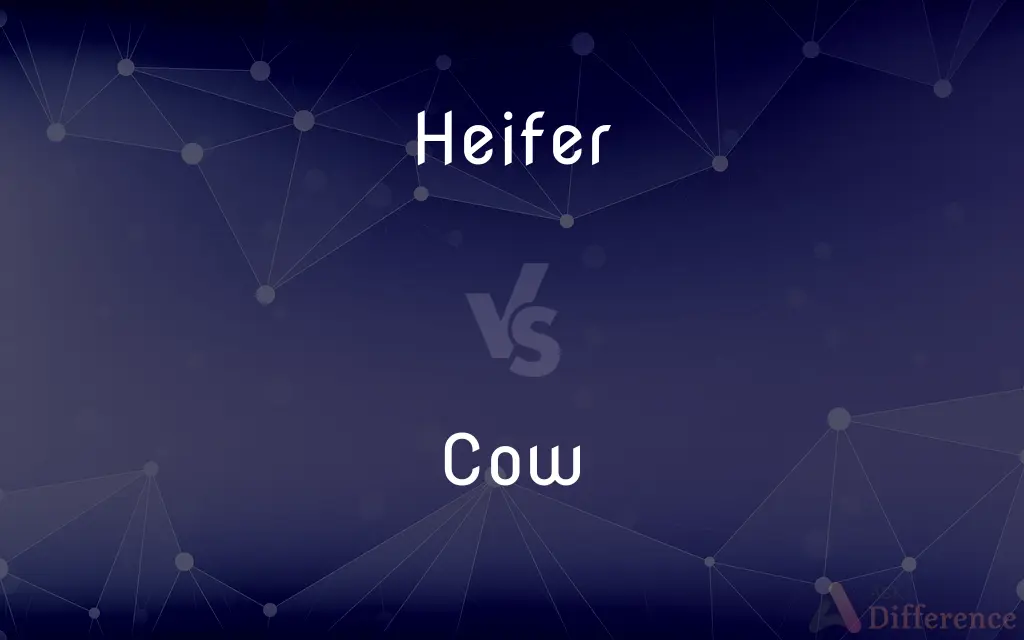Heifer vs. Cow — What's the Difference?
Edited by Tayyaba Rehman — By Maham Liaqat — Updated on April 18, 2024
A heifer is a young female bovine that has not borne a calf, typically under 2-3 years old, while a cow is a mature female bovine that has given birth.

Difference Between Heifer and Cow
Table of Contents
ADVERTISEMENT
Key Differences
Heifers are young female cattle that have not yet calved and are generally under the age of two to three years. Whereas cows are mature female bovines that have given birth at least once and are typically involved in milk production.
Heifers are often raised for breeding purposes, becoming cows once they have delivered their first calf. On the other hand, cows are essential in dairy farming for milk production, continuing to calve to maintain milk supply.
Heifers require specific care and management to ensure successful future reproduction and health. Conversely, cows require different nutritional support focused on milk production and recovery post-calving.
The transition of a heifer into a cow marks a significant point in cattle farming, impacting herd dynamics and productivity.
While heifers represent the growth and future potential of the herd, cows contribute actively to agricultural outputs, whether through milk or additional calving.
ADVERTISEMENT
Comparison Chart
Definition
A young female bovine that has not borne a calf.
A mature female bovine that has given birth.
Age
Typically under 2-3 years old.
Older than 2-3 years, has given birth.
Role in Farming
Raised for breeding to become a cow.
Involved in milk production and breeding.
Nutritional Needs
Focused on growth and development.
Focused on milk production and recovery.
Contribution to Herd
Potential future producer in the herd.
Current producer of milk and calves.
Compare with Definitions
Heifer
Heifers are integral to cattle breeding programs.
Heifers are carefully monitored for health to ensure they mature into productive cows.
Cow
Cows are central to dairy and beef production.
The farm's income relies heavily on products derived from cows.
Heifer
A heifer is a young female cattle that has not yet calved.
The farmer bought several heifers to expand his breeding stock.
Cow
Cows require dietary management to sustain milk production.
Cows are fed a high-energy diet to maintain high milk output.
Heifer
The management of heifers affects future herd productivity.
Proper care of heifers ensures a healthy, productive future generation of cows.
Cow
The health and welfare of cows impact farm efficiency.
Regular veterinary check-ups ensure the cows are healthy and productive.
Heifer
Heifers typically become cows after bearing their first calf.
Once a heifer calves, she is classified as a cow in the herd records.
Cow
Cows may continue to have calves throughout their productive life.
The average cow may have a calf each year to keep producing milk.
Heifer
Nutrition for heifers is geared towards growth and reproductive health.
Heifers receive a balanced diet to support their development into cows.
Cow
A cow is a mature female bovine that has given birth.
The dairy farm has over 50 cows producing milk.
Heifer
A young cow, especially one that has not yet given birth to a calf.
Cow
The mature female of cattle of the genus Bos.
Heifer
A young female cow, particularly one over one year old but which has not calved.
Cow
The mature female of certain other large animals, such as elephants, moose, or whales.
Heifer
(obsolete) A wife.
Cow
To frighten or subdue with threats or a show of force.
Heifer
A girl or young woman.
Cow
(uncommon) Beef: the meat of cattle as food.
The only meat I eat is cow.
Heifer
A cow: a large, unattractive, unpleasant woman.
Cow
(uncommon) Any bovines or bovids generally, including yaks, buffalo, etc.
Heifer
A young cow.
Cow
(biology) A female member of other large species of mammal, including the bovines, moose, whales, seals, hippos, rhinos, manatees, and elephants.
Heifer
Young cow
Cow
A woman considered unpleasant in some way, particularly one considered nasty, stupid, fat, lazy, or difficult.
Cow
(mining) A chock: a wedge or brake used to stop a machine or car.
Cow
To intimidate; to daunt the spirits or courage of.
Con artists are not cowed by the law.
Cow
The mature female of bovine animals.
Cow
The female of certain large mammals, as whales, seals, etc.
Cow
A chimney cap; a cowl
Cow
A wedge, or brake, to check the motion of a machine or car; a chock.
Cow
To depress with fear; to daunt the spirits or courage of; to overawe.
To vanquish a people already cowed.
THe French king was cowed.
Cow
Female of domestic cattle:
`moo-cow' is a child's term
Cow
Mature female of mammals of which the male is called `bull'
Cow
A large unpleasant woman
Cow
Subdue, restrain, or overcome by affecting with a feeling of awe; frighten (as with threats)
Common Curiosities
How does a heifer differ from a cow?
Heifers are younger and have not calved, while cows are older and have typically produced one or more calves.
What role do heifers play on a farm?
Heifers are raised to replace older cows in the herd and to maintain or increase herd size as future breeders.
At what age does a heifer become a cow?
A heifer becomes a cow after she gives birth to her first calf, usually around two to three years of age.
What are common diseases in cows and heifers?
Common diseases include mastitis in cows and respiratory illnesses in heifers, both of which can affect productivity and farm efficiency.
What is a heifer?
A heifer is a young female bovine that has not yet given birth to any calves.
Can a heifer produce milk before having a calf?
No, heifers must first calve to initiate lactation and become productive milk producers.
How do farmers manage heifer and cow health?
Farmers manage health through regular veterinary care, appropriate nutrition, and maintaining a clean and safe environment.
How do heifers affect herd genetics?
Carefully selected heifers contribute to improving herd genetics, which can affect productivity, milk quality, and disease resistance.
Why are nutritional needs different for heifers and cows?
Heifers need nutrients to support growth and development, while cows need nutrition that supports lactation and recovery post-calving.
What is the lifespan of a cow on a dairy farm?
The productive lifespan of a dairy cow on a farm is typically around 5 to 6 years, though this can vary based on health and productivity.
What are the economic impacts of raising heifers to cows?
Investing in heifer management impacts farm economics significantly, as they are the future milk producers and genetic contributors to the herd.
How many calves can a cow have?
A healthy cow can have one calf per year, depending on the management practices and breeding program of the farm.
What is the main purpose of breeding heifers?
The main purpose is to ensure a continuous supply of cows for milk production, breeding, and maintaining herd size.
Why is the transition from heifer to cow important?
This transition is crucial as it marks the beginning of the animal's productive and reproductive life, directly impacting farm output and efficiency.
What challenges do farmers face with heifers?
Challenges include ensuring proper growth, managing health, and preparing them for breeding and calving.
Share Your Discovery

Previous Comparison
Cloudera vs. Snowflake
Next Comparison
Capacitor vs. CondenserAuthor Spotlight
Written by
Maham LiaqatEdited by
Tayyaba RehmanTayyaba Rehman is a distinguished writer, currently serving as a primary contributor to askdifference.com. As a researcher in semantics and etymology, Tayyaba's passion for the complexity of languages and their distinctions has found a perfect home on the platform. Tayyaba delves into the intricacies of language, distinguishing between commonly confused words and phrases, thereby providing clarity for readers worldwide.
















































